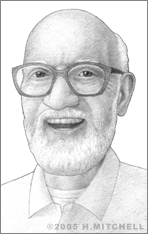Lewis Urry
Lewis Frederick Urry, creator of the world’s first long-lasting alkaline battery, was born in Canada in the city of Pontypool, Ontario, on January 29, 1927. His invention today powers countless portable electronic devices around the world, from flashlights to cameras to computer games.
Urry served in the Canadian army and later enrolled at the University of Toronto, where he completed a bachelor’s degree in chemical engineering in 1950. He then went to work as a development engineer for the Canadian National Carbon Company, a division of Union Carbide, in Toronto. The company manufactured Eveready batteries.
In 1955, the company sent Urry to work in its Eveready research laboratory in Parma, Ohio. There he was charged with the task of developing a longer-lasting battery than those currently available. The concept of batteries was nothing new; they had actually been developed over the last two centuries, with achievements such as the first electric battery developed by Alessandro Volta in 1800. These “electric cells” essentially produce electricity from a chemical reaction.
In the early 1950s, zinc-carbon batteries were most commonly used. They were unpopular, however, for small devices such as toys because they only lasted for a few minutes. Urry decided to approach the problem in an unexpected manner: rather than improve on the current version of the zinc-carbon battery, he thought he would try cells that used an alkaline material. Others had experimented with alkaline components, but so far, no one had been able to find a way to make them cost-effective.
Urry believed he could find the right combination of materials to solve this problem. He found that using zinc and manganese dioxide electrodes alongside an alkaline material that served as the electrolyte, or conducting material, was the perfect setup. The breakthrough, however, was in his idea to use powdered zinc instead of solid zinc as the batteries’ anode, or positive pole, to the manganese dioxide’s cathode, or negative pole.
Urry built test batteries, shaping them into cylinders rather than discs, and tried them in some toy cars he bought at a local toy store. His alkaline battery powered the cars for a very long time while the cars with the older type stopped very quickly. His superiors were immediately impressed. In fact, they put the batteries into production right away. Urry patented the alkaline battery in 1959, and the first Eveready alkaline batteries hit store shelves a year earlier, in 1958. These were renamed “Energizer” in 1980. Union Carbide sold Eveready to Ralston Purina in 1986.
Today, alkaline batteries last up to 40 times longer than Urry’s original prototype. They last five to eight times longer than their zinc-carbon predecessors. Urry achieved a total of 51 patents over the course of his career, and is also credited with the invention of the lithium battery, which continues to grow in popularity today with its use in cell phones and cameras.
In 1960, Urry married and became a U.S. citizen. He retired in May of 2004 and died just a few months later on Oct. 19, at the age of 77. His original prototype battery is now installed in a permanent exhibit at the National Museum of American History in Washington, D.C.


